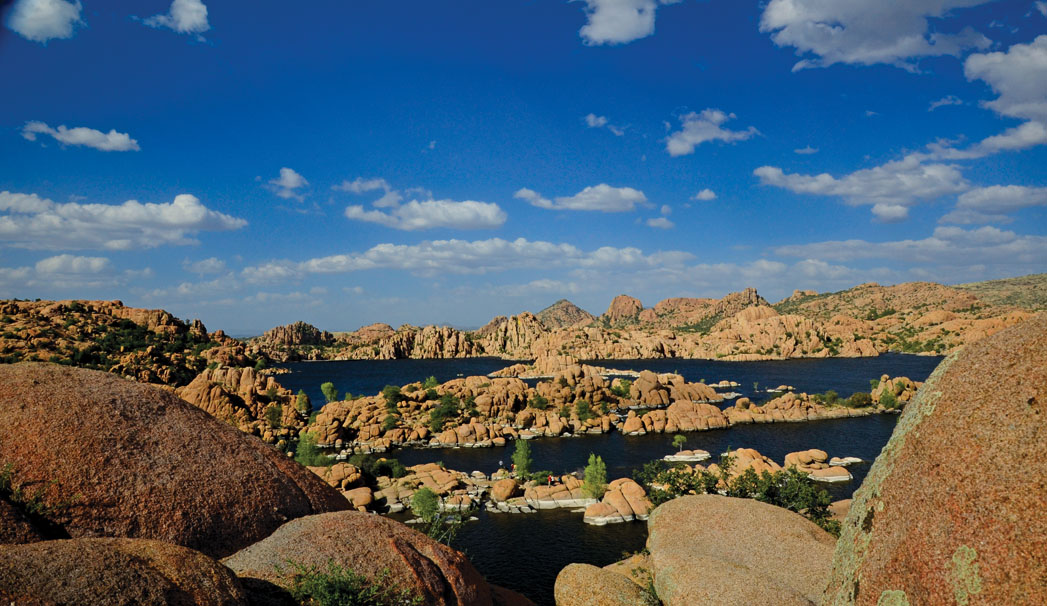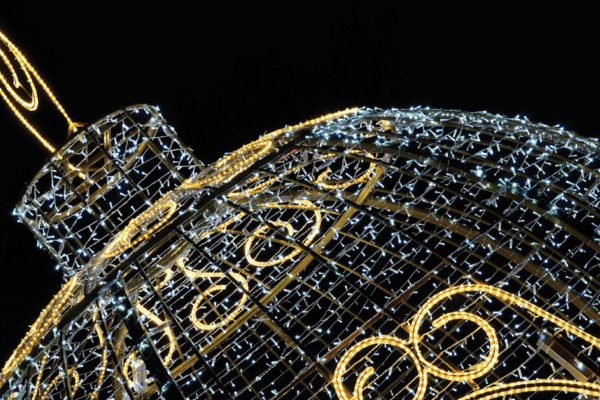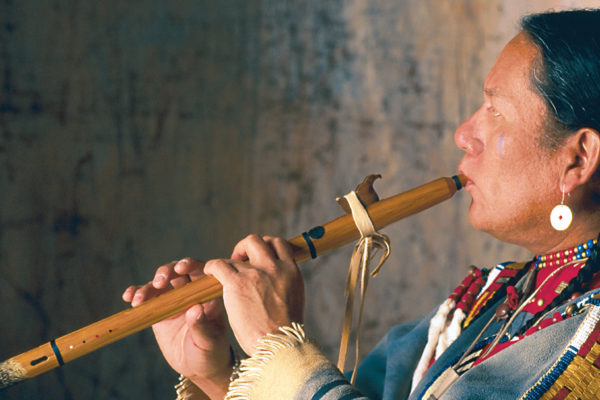Lake Havasu State Park
If the name Lake Havasu conjures up images of girls gone wild on spring break, you’re not completely off the mark: It’s still a party hot spot for coeds in March and April. The rest of the year, however, is a completely different story. “We used to have a season here, but now it’s year-round,” says John Guthrie, western regional manager for Arizona State Parks. “In the winter, we have a lot of snowbirds, and that flows right into spring break season. Spring break flows into summer and fall, which is prime time for the boating crowd. We see about 450,000 to 500,000 people annually.”
Lake Havasu, which straddles the Arizona-California border and is fed by the Colorado River, has a surface area of 25 miles and a shoreline of 450 miles. The lake was created to provide water to thirsty California and Arizona residents when Parker Dam was constructed between 1934 and 1938. Because the water level is controlled by Parker Dam to the south and Davis Dam to the north, there’s not much fluctuation – only about 5 feet, says John. And there’s no shortage of things to do on and around the lake. Since there aren’t any restrictions on boat size (except in Lake Havasu Channel where boats can’t be larger than 50 feet), you’ll see everything from paddleboards to jet skis to luxury houseboats that sleep entire families. You can fish for bass, catfish, stripers, redear sunfish and bluegill. You can swim in water that reaches 85 degrees during this time of the year. There’s biking, hiking (1.75-mile Mohave Sunset Trail meanders through desert and along the shoreline), off-roading and camping at 47 campsites. The Arroyo-Camino Interpretive Garden gives visitors a peek at the wildlife that lives in the surrounding desert. And of course there’s London Bridge, which might be the area’s biggest attraction (aside from the lake itself, of course). Located just outside the state park, the bridge was built in the 1830s to span the River Thames in London. Robert P. McCulloch, who built the master-planned community of Lake Havasu City in 1964, purchased the bridge and had it dismantled and shipped to Arizona in 1967.
The state park has seen plenty of improvements in recent years, says John. There’s a new beach within sight of London Bridge with shade structures, white sand and barbecues. The campground will also undergo renovations in the coming months. Then there’s Cattail Cove State Park, which is about 15 miles south of Lake Havasu State Park but still on the shores of the lake. Upper Cattail Cove is in the process of adding a state-of-the-art campground complete with cabins for those who’d rather go glamping than camping. And in the not-too-distant future, there are plans for Havasu Riviera State Park, which will allow the area to accommodate even more visitors, says John.
The lake has numerous festivals and events throughout the year including rockabilly, boat and hot air balloon festivals. In December, it’s all about the Christmas Boat Parade of Lights. The many events, recreation opportunities and dramatic landscape draw more and more people each year. “There’s not just the lake but also the Colorado River,” says John. “When you’re in a boat traveling north, you’ll drive through Topock Gorge with its cliffs and formations. You can go all the way to Davis Dam in Laughlin, [Nevada], where the water is 15 to 20 degrees cooler. There’s just so much variety.”
This lake is your lake if:
• Anything less than 65 degrees is jacket, scarf and beanie weather to you.
• Your idea of a good day is a case of Bud Light and girls in bikinis.
• Spending a week on a houseboat with your extended family actually sounds like a good idea.
Lake Havasu State Park, 699 London Bridge Road. The park is open 24 hours a day 365 days a year. Parking is $20 per vehicle, Friday through Sunday and holidays; $15 Monday through Thursday ($10 additional fee for oversized vehicles). For information about the lake, visit www.azstateparks.com/lake-havasu or call 928-855-2784. For information on boat rentals, visit www.wetmonkeyrentals.com or call 928-855-2022.
Lake Mead National Recreation Area
It’s absolutely a cliché to say that a location has something for everyone, but there’s no better way to describe Lake Mead National Recreation Area, located just a stone’s throw from the nation’s entertainment capital, Las Vegas. We could devote an entire feature to everything there is to see and do in the 1.5-million-acre parcel of land on the Arizona-Nevada border that includes both Lake Mead and Lake Mohave. This year, more than seven million people will flock to the recreation area to boat 290 square miles of waterway, swim, scuba dive, bike, jet ski, raft, ride horses, picnic, camp, hike, fish (striped bass, carp, catfish and more), hunt and off-road. They will see billion-year-old rocks, black lava flows, the remains of ancient seas, arches, petroglyphs, narrow canyons and the ruins of a ghost town that was once underwater. If they are lucky, they might even spot a desert bighorn sheep or a desert tortoise. It’s no wonder that the recreation area is the seventh most visited national park, says Chelsea Kennedy, public affairs specialist for Lake Mead National Recreation Area.
Of course, the lake’s major attraction – and the reason for its existence – is the Hoover Dam. The dam was completed in 1936. South of the dam, Lake Mohave – with the gambling town of Laughlin on its shores – formed in 1951 when Davis Dam was built. The two lakes together comprised our nation’s first national recreation area with the creation of Lake Mead National Recreation Area in 1964. (Lakes Mead and Mohave hold more than 4 trillion gallons of water, and Lake Mead is the largest and one of the cleanest reservoirs in North America.) The lakes reached their capacity nearly 20 years later in the summer of 1983. “Lake Mead is comprised of the two largest basins within the park,” says Chelsea. “The Boulder Basin and Virgin Basin are large open lakes and are the closest to Las Vegas. Lake Mohave is below Hoover Dam. Lake Mohave has the only national water trail designation in the southwest and in a desert.”
That water trail is the 30-mile Black Canyon National Water Trail, ideal for kayaking or canoeing. (Tip: If you’re looking for a tranquil experience, paddle the trail on Sunday or Monday when motorized vessels aren’t allowed.) Speaking of peace and quiet, the park boasts nine wilderness areas. Backcountry camping is allowed, though hiking in the summer, when temperatures can reach 120 degrees in the shade, is discouraged. There is one trail that’s relatively safe to explore at this time of the year, though. The 7.5-mile round-trip Historic Railroad Trail consists of five tunnels that lead to the Hoover Dam. It also offers up great sunset views. As you might expect to find in such a large recreation area, there are 1,229 developed campsites at the two lakes including many located along beaches and in coves (some sites take reservations while others are first come, first served). There are nine developed visitor areas with marinas, docks and restaurants. Looking to escape the heat for a few hours? Book a tour of Hoover Dam, once the world’s tallest dam. There are boat tours of the dam, too.
If you’re really looking for a unique experience along the lake, head to St. Thomas, a pioneer settlement built in 1865 on the Nevada side of the lake. “Lake Mead National Recreation area is full of hidden gems for visitors to enjoy and explore,” Chelsea says. “One of the lesser-known areas within the park is the St. Thomas town site which was underwater after the dam filled the lake and re-emerged when lake levels began to recede.”
This lake is your lake if:
• …oh forget it. If you have a pulse, you’ll find something here you enjoy. This lake is everyone’s lake.
Lake Mead National Recreation Area is located on the Arizona-Nevada border off US 93. The lakes are open year-round, 24 hours a day. Parking is $20 per vehicle per day. Annual passes are available. For more information, visit www.nps.gov/lake or call 702-293-8990. Several concessioners rent boats at Lake Mead and Lake Mohave. Visit the park’s website for a list of boat rentals and contact info.




